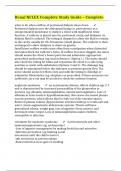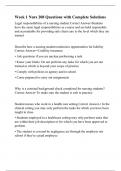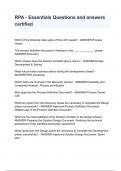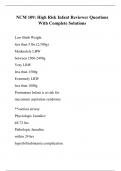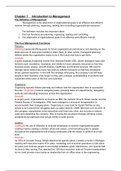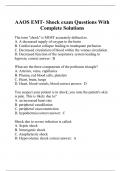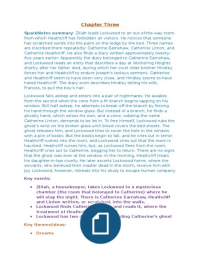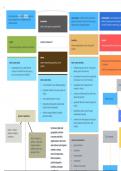what to do when outflow of peritoneal dialysis slows down - ✔️
Peritoneal dialysis uses the abdominal lining (ie, peritoneum) as a
semipermeable membrane to dialyze a client with insufficient renal
function. A catheter is placed into the peritoneal cavity, and dialysate (ie,
dialysis fluid) is infused. The tubing is clamped to allow the fluid to remain
in the cavity, usually for 20-30 minutes (dwell phase). The catheter is then
unclamped to allow dialysate to drain via gravity.
Insufficient outflow results most often from constipation when distended
intestines block the catheter's holes. If outflow becomes sluggish, the nurse
should assess the client's bowel patterns and administer appropriate
prescribed medications (eg, stool softeners) (Option 1). The nurse should
also check the tubing for kinks and reposition the client to a side-lying
position or assist with ambulation (Options 3 and 5). The drainage bag
should be maintained below the abdomen to promote gravity flow. The
nurse should assess for fibrin clots and milk the tubing to dislodge or
administer fibrinolytics (eg, alteplase) as prescribed. If these measures are
ineffective, an x-ray may be needed to check the catheter location.
nephrotic syndrome - ✔️ an autoimmune disease, affects children age 2-7
and is characterized by increased permeability of the glomerulus to
proteins (eg, albumin, immunoglobulins, natural anticoagulants). Loss of
albumin in urine leads to hypoalbuminemia; this causes decreased plasma
oncotic pressure, which allows fluid to leak out of the vascular spaces.
Reduced plasma volume (hypovolemia) activates kidneys to retain salt and
water (renin-angiontensin-aldosterone system). Clients will have
generalized edema, weight gain, loss of appetite (from ascites), and
decreased urine output. Loss of immunoglobulins makes children
susceptible to infection.
treatment for nephrotic syndrome - ✔️ -Corticosteroids and other
immunosuppressants (eg, cyclosporine)
-Loss of appetite management by making foods fun and attractive
-Infection prevention (eg, limiting social
interaction until the child is better)
-salt restriction to prevent edema
-fluid restriction in wt gain or swelling
,-test urine for protein daily, weigh child weekly
hemolytic-uremic syndrome - ✔️ Hemolytic-uremic syndrome (HUS) is a
life-threatening disease characterized by a triad of hemolytic anemia
(anemia caused by destruction of red blood cells), acute kidney failure
(uremia), and a low platelet count (thrombocytopenia). It predominantly,
but not exclusively, affects children. Hemolysis results in anemia, and low
platelets manifest as petechiae or purpura. Therefore, the presence of
petechiae in this client could indicate underlying HUS and needs further
assessment.
Blood-streaked stool is a common symptom associated with what - ✔️
intestinal irritation
why are fruit drinks contraindicated in diarrhea - ✔️ Fruit juices are
discouraged in acute diarrhea as they have high sugar (osmolality) and low
electrolyte content. Continuing the client's normal diet (solid foods) is
encouraged as it shortens the duration and severity of the diarrhea.
characteristics of acute glomerulonephritis - ✔️ Clinical manifestations
include periorbital and facial/generalized edema, hypertension, and
oliguria, which are primarily due to fluid retention (decreased kidney
filtration). The urine is tea-colored and cloudy due to the presence of
protein and blood.
Although most clients recover spontaneously within days, severe
hypertension is an anticipated complication that must be identified early.
Monitoring and control of blood pressure are most important as they
prevent further progression of kidney injury and development of
hypertensive encephalopathy or pulmonary edema.
hematuria is normal
The most important measure of fluid status is a daily weight as it identifies
fluid retention and response to treatment. Monitoring intake and output is
important but is not the priority action over hypertension monitoring and
control.
, what is acute glomerulonephritis usually caused by? - ✔️ an immune
complex disease most commonly induced by prior group A beta-hemolytic
STREPTOCOCCAL infection of the skin or throat. A latent period of 2-3
weeks occurs between the streptococcal infection (eg, pharyngitis) and the
symptoms of AGN.
creatinine clearance test - ✔️ Creatinine clearance is a measure of
glomerular function and is a sensitive indicator of renal disease
progression. A 24-hour urine collection is needed for the test. When the
test begins, the first urine specimen is discarded and the time is noted. All
other voided urine for the next 24 hours is collected in a container and
kept cool. At the end of the 24 hours, the client should void one last time
and add the specimen to the container. Blood is drawn to measure serum
creatinine level in addition to urine creatinine.
The results are used to calculate the amount of creatinine that has been
cleared from the blood and passed into the urine.
what is the most appropriate procedure for a client with sudden acute
kidney failure that requires immediate dialysis? - ✔️ central line in the
groin area. The catheter should always be the last access option for long-
term dialysis due to risk of infection and mechanical malfunction (eg,
thrombosis). it will be used until an AVG or AVF is ready to use.
it is preferred over an arteriovenous graft (AVG) or arteriovenous fistula as
these takes weeks to heal.
peritoneal dialysis is contraindicated as it is a gradual removal of waste and
is a slow process. it is more useful for patients who want to live at home
because it requires multiple exchanges a day.
pessary - ✔️ A pessary is a vaginal device that provides support for the
bladder. Clients can remain sexually active while wearing a pessary. They
are fitted for the proper type and size by an HCP in the office. Surgery is
not required for pessary placement; clients who are able can insert and
remove the pessary themselves. If a pessary or other treatment (eg, pelvic
muscle exercises, estrogen replacement therapy) is ineffective,
reconstructive surgery may be indicated.

